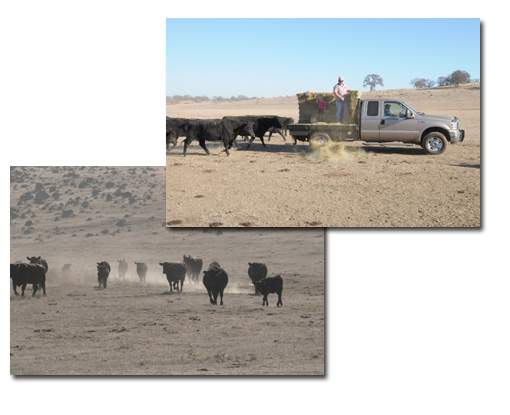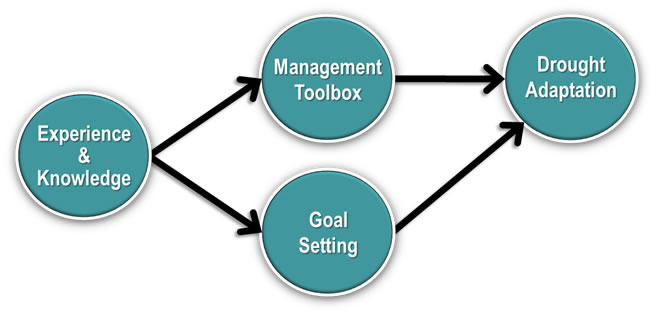Drought Impacts on California Ranches — Evaluating drought response and recovery strategies
Given the extent, and severity of the current drought, we are interviewing livestock producers to learn more about the real impacts of this drought on their operations. We will conduct telephone surveys with ranchers to examine drought management strategies, economic and ecological impacts, and drought adaptation and recovery strategies resulting from one of our most severe droughts on record. >>More
Managing For Drought
Having a drought strategy is pertinent to the sustainability of any ranch enterprise, especially when faced with a winter that has thus far produced below normal precipitation following an extremely dry water year. We have provided info to help prepare for the various stages of a drought.
Ranching and California's Drought – A Workshop and Webcast
On November 7, 2014, we brought the U.S. Drought Monitor authors and the California State Climatologist to UC Davis to talk about 1) how the U.S. Drought monitor is updated weekly; and 2) how local expert knowledge, real time ranch impacts, and other relevant data can be used to inform the U.S Drought Monitor. We also shared new information on California Ranchers’ perceptions and experiences with drought, new livestock feeding strategies during drought, and seasonal weather forecasts for California. See Video and Presentations
Ranchers' Perspectives and Management Strategies for Drought
Contact — Leslie Roche
Background. Over the past two years, we have been conducting a statewide mail survey and interviews of California ranchers in part to 1) improve connections between ranchers' and researchers' knowledge bases to identify strategies to adapt to challenges like drought; and 2) compile and share the knowledge and expertise of experienced ranchers. Information on the mail survey can be found in Lubell et al. 2013, and information about the rancher interviews conducted can be found at the California Ranch Stewardship Project.
Preliminary Results. In 2011, we asked 509 California ranchers, "If another drought were to begin this year, how severely would this impact the economic viability of your operation?" Nearly three-quarters of respondents (n=477) indicated the impact to their operations would be as severe or worse than past droughts, while only 12% indicated the impact would be less severe than in previous droughts. In recent in-person interviews across California, 76% (n=60) of ranchers stated they expected to see impacts to their operations if drought conditions persisted into the coming year—and 35% of those interviewed expected devastating impacts to the viability of their operations. Several ranchers interviewed noted that a statewide severe drought would exacerbate the effects of earlier consecutive droughts in their regions.
In the statewide mail survey, nearly all ranchers (99%; n=443) reported that they had employed reactive drought strategies—using at least one or a combination of management practices in response to drought. A majority of ranchers (64%; n=443) also reported that they utilized proactive drought strategies—using at least one or a combination of practices to prepare them for potential future drought.
Rancher experience and knowledge (i.e., number of generations ranching, number and quality of information sources, and education level) positively influenced ranch goal setting—specifically, prioritization of forage production goals—and the management toolbox (i.e., number of active conservation programs, number of key practices used, and diversity of forage resources). Goal setting and the management toolbox had direct positive effects on adaptive strategies for drought impact management—including the number of proactive and reactive drought management practices used, and having an in-place drought management plan.

 Next Steps. We are currently wrapping up analysis of the survey responses and are developing research papers and extension education products. We are continuing to interview ranchers across the state. If you are interested in participating, or would like more information please see California Ranch Stewardship Project or contact Leslie Roche.
Next Steps. We are currently wrapping up analysis of the survey responses and are developing research papers and extension education products. We are continuing to interview ranchers across the state. If you are interested in participating, or would like more information please see California Ranch Stewardship Project or contact Leslie Roche.
Key Drought Publications
 Drought-Related Poisoning and Nutritional Risks to Cattle
Drought-Related Poisoning and Nutritional Risks to Cattle
" Drought can increase the risks of animal poisonings and nutritional imbalances. In addition, should drought-breaking rains occur, the grazing conditions for cattle may dramatically change and pose additional health risks. "
 Livestock Management During Drought
Livestock Management During Drought
"Drought years create servere hardships for the livestock industry. . . Sound rangeland and livestock management strategies can help a livestock operation survive a drought. . . The following is a series of range and livestock management recommendations that you may consider."
 Determining Drought On California's Rangelands
Determining Drought On California's Rangelands
"Recent droughts in both developing and developed countries and the resulting economic and environmental impacts and personal hardships have underscored the vulnerability of all societies to this "natural" hazard. . . We begin by discussing the characteristics of drought in California, and then consider the NAP and its application to California conditions."
 Estimating Cost of Replacing Forage
Estimating Cost of Replacing Forage
"Calculations take into account the forage productivity of the site, the reduction in productivity due to a disturnbance, the RDM standard necessary to protect the site, the grazing efficiency of grazing livestock, and the number of acres affected. In addition, the final worksheet in each file calculates the cost of replacing lost forage with comparable hay."
 Q&A: Tax Options for Drought Sales of Livestock
Q&A: Tax Options for Drought Sales of Livestock
" If a producer is forced to sell livestock, in excess of normal levels, due to shortages of water, feed or other consequences of drought, the income tax on the gain from the sale of those animals may be postponed. "
 Weather-Related Sales of Livestock
Weather-Related Sales of Livestock
"There are two provisions in tax law which attempt to cushion producers from the consequences of adverse weather-related livestock sales. Under the first provision, livestock held for draft, breeding or dairy purposes and sold due to adverse weather are provided a two-year reinvestment period... The second provision, which applies to all livestock (other than poultry), allows cash basis taxpayers whose primary trade or business is farming to defer receipt from sales in excess of normal business practices due to weather-related conditions that result in a disaster declaration area."
 A Drought-Planning Methodology for Ranchers in the Great Plains
A Drought-Planning Methodology for Ranchers in the Great Plains
" Ranch drought planning is important for identifying management priorities, proactively evaluating management options before a drought occurs, and ultimately reducing the effects of drought on an operation and the grasslands that support it. "
 Drought Economics
Drought Economics
"There are many considerations that need to be thought through to develop a drought plan that makes sense for your ranch. How many cows do you want to try to keep?...As you reduce herd numbers, how will fixed costs be covered?...How do you rebuild the herd after the drought ends?"
.jpg) Top 10 Drought Management Tips for Ranchers
Top 10 Drought Management Tips for Ranchers
"1. Adjust stocking rates to match drought-induced reductions in forage yield, in order to avoid longterm damage to the base forage resource. Several feasible options exist to effectively reduce stocking rates on pastures. Consider early weaning to reduce the quantity and quality of feedstuffs needed to meet cow nutritional requirements."
 Drought Management Strategies for Beef Cattle
Drought Management Strategies for Beef Cattle
"Drought is a serious obstacle to successful range livestock management. Producers must understand how drought affects plants, grazing animals, and livestock management, and what options exist."
 Use of Alternative feedstuffs in Cow Calf Operations
Use of Alternative feedstuffs in Cow Calf Operations
Using by-product feeds can reduce rancher feed costs. We have included a presentation and supporting document on nutritional values of feed to assist in the decision making regarding the utilization of by-product feeds in beef cattle diet.
 Drought-Related Poisoning and Nutritional Risks to Cattle
Drought-Related Poisoning and Nutritional Risks to Cattle
"Drought can increase the risks of animal poisonings and nutritional imbalances. In addition, should drought-breaking rains occur, the grazing conditions for cattle may dramatically change and pose additional health risks."
 Limit Feeding Concentrate Diets to Cows
Limit Feeding Concentrate Diets to Cows
" In years when hay and forage production is low due to drought, hay prices often escalate and in severe cases, forage of any kind may be hard to come by. In situations like this, some producers should consider limit feeding concentrate diets to cows. Depending on the price of grain, nutrients to maintain and grow cattle may be cheaper to purchase through concentrate feeds rather than roughage. "
 Evaluating a Early Weaning Drought Management Strategy
Evaluating a Early Weaning Drought Management Strategy
" It can be challenging to cost effectively lease pasture, feed energy, or sell cows just to buy them back when forage production improves. Early weaning, especially when combined with one or more of the other options listed, can be a useful tool to manage forage supply while minimizing the need to feed energy or dramatically liquidate cattle. "
 Soil-Moisture Monitoring
Soil-Moisture Monitoring
"A Simple Method to Improve Alfalfa and Pasture Irrigation Management. Irrigation water is essential for profitable crop production in most of the arid West. Proper irrigation management is key for high yields and to avoid stress from too much or too little water. Improper irrigation management limits yields more often and to a greater degree than any other production factor."
 Drought Feeding and Management of Beef Cattle
Drought Feeding and Management of Beef Cattle
"This booklet is a practical guide that will assist you to manage the planning, feeding andrecovery periods of a drought. It contains a range of technical information adaptable to individual conditions and situations, and tools to reduce the costs and impacts incurred."
Drought Feeding and Management of Sheep
"This booklet is a practical guide on sheep feeding and management during a drought to help producers break down into manageable steps the daunting planning phase, and see the plan realised as a successful way of combating the drought."
TAX ADVICE DISCLAIMER: The information in this article is a guide to help you examine the management options available to you. To ensure that you qualify for tax relief under either of these code sections it is advisable to speak with a tax professional. Any federal and/or state tax advice contained in this communication (including attachments) was not intended or written to be used, and it cannot be used, by you for the purpose of (1) avoiding any penalty that may be imposed by the Internal Revenue Service or (2) promoting, marketing, or recommending to another party any transaction or matter addressed herein.



